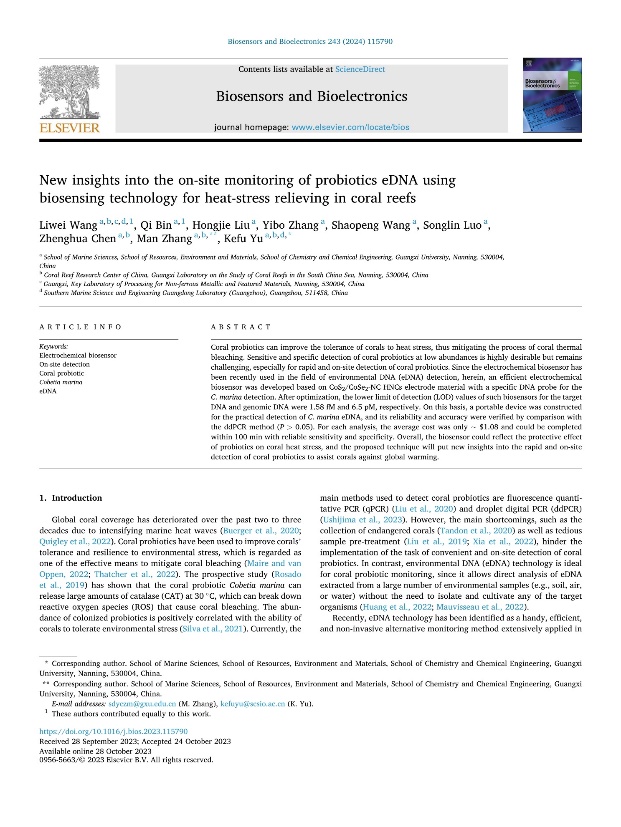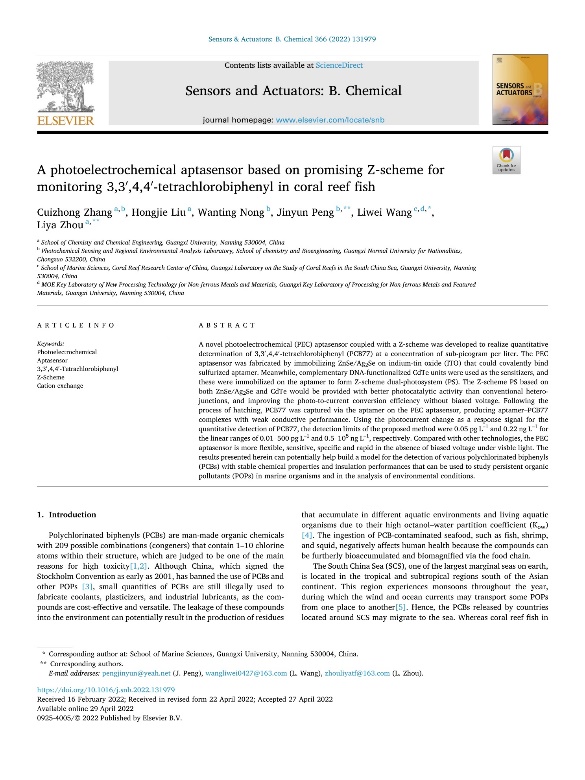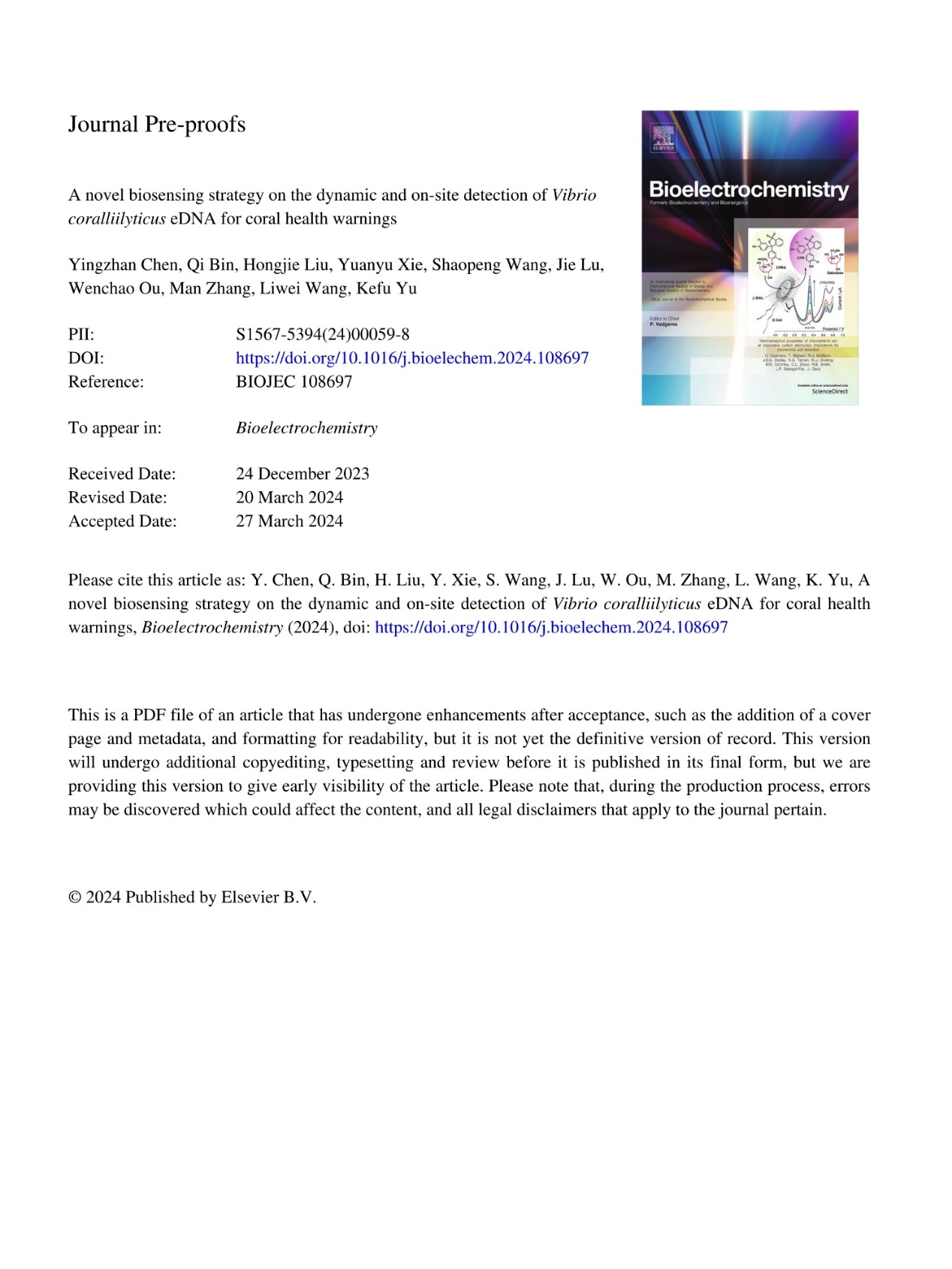eDNA: A Series of Research Progresses in Health Monitoring and Risk Warning of Coral Reefs
As the potential "blue carbon sinks", coral reef ecosystems are one of the most species-diverse and resource-rich ecosystems in the world. However, the global coral reef system is undergoing rapid degradation due to climate change, coral diseases, crown-of-thorns starfish outbreaks, and various human activities, so it is very important to monitor and assess the health state of the coral reef ecosystem. However, traditional methods for monitoring the health status of coral reefs are costly and unable to meet the demand for real-time, dynamic, and rapid monitoring. There is an urgent need to develop automated and portable assessment technology for real-time monitoring of coral reef ecosystems, especially for quantitative tracing of disaster-causing organisms and early warning of their outbreaks. Therefore, Associate Professor Liwei Wang and her team members have utilized the advantages of environmental DNA (eDNA), such as non-invasive sampling, simplicity, high efficiency, and so on, to explore its application in the field of coral reef health monitoring and risk warning, and a series of achievements have been achieved:
1. Research progress of DNA biosensor for Crown-of-Thorns Starfish (COTS) based on eDNA tracing
Crown-of-thorns starfish (COTS) is known as a coral killer, which can devastate coral reef ecosystems in case of a large-scale outbreak. At present, the traditional techniques for tracing and quantitative assessment of COTS have deficiencies, which make it difficult to trace COTS in the water column accurately, and there is still a lack of effective means of tracing and early warning, which is a global ecological problem. Therefore:
(1) we pioneered constructing an eDNA electrochemical biosensing platform for COTS and realized a rapid, accurate, and in situ assessment of COTS at the scientific research site in the sea area of the coral reef zone. This technology provided new ideas and technical support for tracing and early warning of COTS outbreaks, and the related results were published in the TOP journal: Biosensors and Bioelectronics, 2023, 230, 115265. (IF=12.6). https://doi.org/10.1016/j. bios.2023.115265.
(2) Using a programmed catalytic hairpin assembly/hybridization chain reaction (CHA/HCR) cycle amplification strategy, a novel and highly efficient electrochemical biosensor of DNA from the COTS was constructed for the in-situ detection of eDNA from the COTS, which achieved a limit of detection (LOD) of 18.4 fM; and a limit of quantification (LOQ) of 41.1 fM. In addition, the correlation between eDNA concentration and the population density of the COTS was established (r = 0.990; P < 0.001). This technique provided new insights for field monitoring and early warning of COTS outbreaks. The results have been published in the TOP journal: Science of The Total Environment (IF = 9.8). https://doi.org/10.1016/j.scitotenv.2024.172258.
2. Dynamic monitoring of coral probiotics and coral health assessment based on eDNA technology
Coral probiotics can effectively enhance coral tolerance to thermal stress, thus delaying the process of coral thermal bleaching. Therefore, there is an urgent need for rapid, in-situ detection of coral probiotics at low concentrations, and it is even more challenging to develop rapid and convenient coral probiotic monitoring techniques. Hence, Wang et al. developed a novel electrochemical DNA biosensor to realize the dynamic monitoring, coral risk classification, and health warning of the antler cup-shaped coral probiotic, C. marina. The detection technique can reflect the protective effect of the probiotic under coral heat stress and provide new ideas for coral reef health assessment and protection in the context of global warming. The related results have been published in the TOP journal: Biosensors and Bioelectronics, 2024, 243, 115790. (IF=12.6). https://doi.org/10.1016/j.bios.2023.115790.
3. Dynamic monitoring of coral pathogenic bacteria and early warning of coral bleaching based on eDNA technology
Coral diseases are one of the main causes of the decline in coral reef cover. Studies have shown that Vibrio coralliilyticus is a temperature-dependent pathogen that causes tissue lysis in staghorn cup-shaped corals, and the current methods for detecting V. coralliilyticus are unable to satisfy the needs of non-invasive detection and real-time dynamic monitoring. Therefore, Wang et al. constructed a sensing platform for rapid detection of V. coralliilyticus eDNA based on electrochemical DNA biosensing technology, which has excellent specificity for V. coralliilyticus eDNA, the detection limit can be as low as the picomolar level, and the ddPCR results showed that the constructed electrochemical DNA sensor exhibited high accuracy. In addition, the constructed electrochemical DNA biosensor was utilized for the detection of eDNA from the infected and healthy groups of V. coralliilyticus, and the preliminary results from the electrochemical DNA biosensor had a good correspondence with the coral infection level. Hence, this technology provided an effective strategy for monitoring coral health and early warning of the risk of bleaching. The results were published in the classic journal: Bioelectrochemistry, 2024, 158, 108697. (IF=5). https://doi.org/10.1016/j.bioelechem.2024.108697.
4. Rapid detection of organic pollutants in coral reef areas
A novel photoelectrochemical aptamer sensor coupled with a Z-type heterojunction was developed to quantitatively monitor ultra-trace 3,3`,4,4`-tetrachlorobiphenyl (PCB77) organic pollutants in coral reef zone fish. This work was published in the TOP journal: Sensors and Actuators B: Chemical, 2022, 366, 131979. (IF = 8.4).https://doi.org/10.1016/j.snb.2022.131979.



